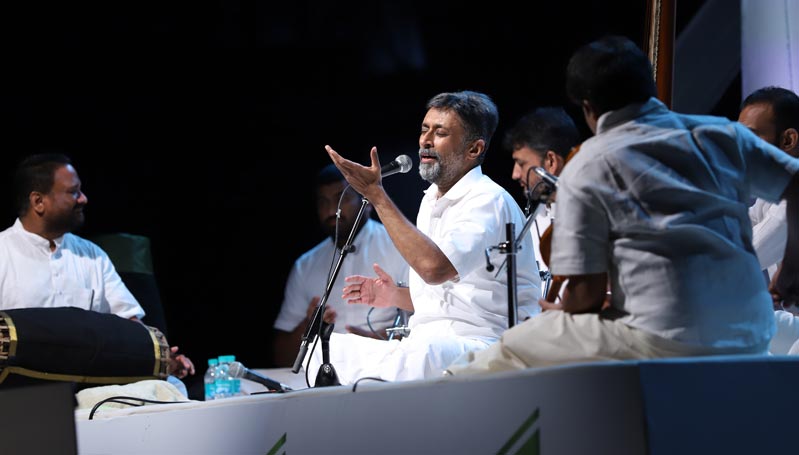
My friend Sanjay Subrahmanyan is one of the top classical vocalists of India. Before Covid, he regularly performed at South India’s equivalent of Lincoln Center, for crowds of almost 2,000. After countless delayed and cancelled concerts, Sanjay eventually decided to go rogue. In January 2021, he launched a YouTube channel membership—a direct-to-consumer plan.
I thought this was a fascinating move, especially for someone whose audience consists predominantly of Baby Boomers, in the relatively conservative industry of Carnatic music
Sanjay described the change to me like this:
“In the past, the Music Academy and 10-15 other organizations would come together to produce one huge music festival. It’s a 30-day extravaganza with 5 concerts per venue per day. This was like being one flower in a bouquet. People are used to paying for the bouquet. Now, I’m asking them to pay for just one flower.”
Sanjay has three tiers of subscribers, using YouTube memberships. The basic tier is free, and everyone receives access to hundreds of archived recordings that Sanjay and his wife Aarthi have been collecting since the early 2000s. There are thousands of hours of these, and he releases more regularly. The second tier ($1 per month) gets a preview of the new uploads before they’re released to everyone else. The top tier ($10 per month) gets a brand-new concert every month, released to them exclusively. Sanjay gets together his accompanists, heads to a recording studio with a video and audio team, and performs and records a 90 minute concert each month.
Before the pandemic, the online world and business was a hobby for him. From discovering usenets in 1995 on a trip to the US to releasing songs on mp3s in the late nineties, he’s been personally fascinated with using and discovering new technology and exploring what was out there for his profession. But he considers it just dabbling. He never looked at online as a full-time business proposition because he was busy performing 50 to 60 concerts a year, all through inbound invitations. He was an early user of Gumroad and had also been releasing albums on Spotify and making a lot of his performances free on YouTube.
“But over the last three or four years,” Sanjay told me, “I realized the trend was more toward video: people want to see you, especially during the pandemic. I picked YouTube partly for that reason, and partly because it was very simple for subscribers. Most of my fans are in their 60s, so they need something simpler than Patreon or Gumroad. That’s why I use YouTube, even though their cut is 30%.”
A few takeaways from this:
First, ease is important; fans will be more open to paying if it’s really easy for them to sign up and access their stuff, so a platform where they already spend time has an added benefit.
Second, existing networks compound; YouTube is a compounding engine for Sanjay’s subscriber base. He has ~30,000 basic subscribers on YouTube. Converting a few of these people to paying subscribers and providing the rest with fresh content will reap dividends over time.
Third, it’s so important to keep a record of everything, so you have plenty of content to share and choose from. For a performer, it’s obvious how to do so – record everything. But for a visual artist, don’t discard “work in process” or little day-to-day projects. For a writer, even snippets that show how you work can be valuable. It’s not a big, fully wrapped deliverable, but it’s work you still created.
Sanjay realized that he had to share his performances with his audiences to stay relevant. He also realized he deeply missed performing. Performers have to perform!
To go from singing 60 concerts a year—which included planning and preparing, coordinating with accompanists, experiencing the joy of the performance and the gratitude of having an audience appreciate it—down to zero concerts in three months is very hard for someone who performs at the highest levels. And to lose a year of performance revenue in his prime was not easy. But it was a forcing function that made him take the leap into developing a direct relationship with his audience.
Sanjay has had to evolve from a performer focused on his craft to someone who has to focus on the business side of the equation. To use his creativity and apply it to areas like logistics and business operations, to marketing and branding.
This has unlocked new forms of creativity for him. While he’s primarily a performer of existing compositions, he has on occasion arranged new compositions. But these were all still vocal arrangements that were delivered during live concerts. In the past couple of months, he’s explored how to use video more creatively. He recently created a new arrangement of a beautiful poem called “Tamizhan endroru inamundu,” which means “Tamilians are a tribe.” His collaborators filmed it and developed a visual treatment for the poem.
For creators, will the hybrid model will become the default? Will more artists go rogue like Sanjay? Who are the kinds of creators who will be able to do this? Sanjay is typically a performer of music that other people have composed, so it’s been a relatively low-lift for him to produce new content. What about filmmakers, who have to bring a much bigger team together with (almost always) a bigger expenditure/budget? What about writers or composers, where each piece may take months and many drafts before it’s ready to share?
The “creator” economy is a very broad term that covers creators who are so different from each other in terms of frequency of creation, complexity of creation, ability to share work in progress, and so many other dimensions. It’s in the nuance of the differences that opportunities exist for both creators and for the tech solutions that serve them. Where will we go next?
